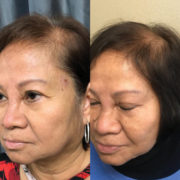
MANY people refer to the hair as one’s crowning glory. I could say the same for very good reasons. The hair, being one of the first things people see when trying to recognize someone, can tell a lot about a person and may affect how he or she is perceived.
With all things considered, our hair is after all, the crown we never take off. That said, I understand the stress it causes when our “crown” is in the process of “fading away.”
Good thing, modern technology has brought us this hair restoration treatment. This treatment Improves circulation to the dermal plexus, inhibits the activity of
5-alpha Reductase and promotes follicular keratinization. This fusion ensures optimal function at a cellular level, optimizing cellular metabolism with a powerful boost of vitamins and micro-nutrients
That may sound a tad bit technical so in order for us to fully understand this treatment, let us talk about the process of hair growth (or the loss of it).
Contrary to what most people think, female hair is not too different from male hair in terms of growth cycle and structure. Both contain the three parts responsible for these processes which are the scalp, the visible part of the hair, and the shaft which is made of three layers:
the first is the external layer known as the Cuticle, which is formed with protective overlapping scales; the middle layer, known as the cortex, is made up of keratin fibers grouped together in spindle-like shapes. This layer contains the pigments responsible for the hair’s natural color and the inner layer or the Medulla.
Our hair is constantly renewing itself. A single hair emerges, grows, then falls out, as part of a hair cycle that repeats itself about 25 times during our lifetime and occurs in three stages: The Anagen phase, or growth phase which lasts about two to three years in men and six to eight years in women. Under normal conditions, about 85% of our hairs are in the Anagen phase. During this phase, the vascular network that supplies the hair root is particularly well-developed around the follicle.
Second is the Catagen phase, or regression phase, which is fairly brief (2 to 3 weeks), during which the hair follicle becomes inactive. The matrix dies and although the hair does not grow anymore, it remains rooted in the follicle. Lastly, there is the Telogen phase, when the hair is in its rest phase. The hair sheds and is replaced by another hair, whereby a new Anagen phase begins. This period of renewal lasts approximately three months and explains why we normally lose around 100 hairs every day.
Now there are two types of hair loss. There is gradual hair loss and sudden hair loss. The gradual hair loss, also called Andro-genetic Alopecia, is a gradual and localized decrease in the capillary mass. In humans, it extends most often at the level of the frontal lobes, the top of the head and the tonsure. In women, it is frequently located on the temporal zones and the ray. This is usually caused by a reduced Anagen (growth) phase linked to progressive degeneration of the hair follicles. Each cycle becomes shorter than the one before. Finally, the follicle wears out completely, is reabsorbed, then disappears. The succession of 20 to 25 hair growth cycles, which should last a lifetime, ends sooner than expected.
Gradual hair loss or alopecia is dependent on certain male hormones, androgens, which are also present in women. This also explains why this phenomenon only begins after puberty.
Gradual hair loss is an abnormal reaction of the hair and scalp to these hormones.
Sudden hair loss, on the other hand, is usually caused by poor circulation and nutritional deficiency. Growth factors are responsible for increasing the blood flow to the hair follicle. This function is essential to regulating hair growth. Poor circulation to the scalp means the hair bulb does not receive the nutrients it needs and results in hair loss.
Now that we know the hair structure and its growth process (or loss thereof), we can now see how this hair restructuring treatment works. First, it’s triple action at the heart of the dermal papilla extends the life of the hair, making it a highly effective active ingredient against gradual hair loss.
Second, it induces the Anagen phase, which makes it possible to rapidly restart hair growth and marks it out as a highly effective key ingredient against sudden hair loss. The treatment starts with a soft or deep cleansing of the scalp by a cleaner. Followed by applying 3-5ml of the hair loss control solution. After this, the “Microneedling” in sections begins. This is mixed with vitamin complex and hair lotion. This process is concluded by exposing the area to LED or red light for 20 minutes.
Our “crowning glory” plays a huge factor in our overall appearance that people would go through lengths to take care of it, let alone save it. And this treatment may actually be the one that you’ve been waiting for.
Visit iSkin or Image Body Spa for a free consultation. iSkin is located at 8709 Beverly Blvd., West Hollywood, CA. Image Spa MD is located at 9227 Haven Ave. Suite 120 Rancho Cucamonga, CA and 499 N El Camino Real, suite c-200, Encinitas, CA.
***
Imee is an established aesthetician, a business owner and a managing partner for Image Spa MD and CEO of Image Body SPA. She has a degree in Biology and Doctor of Dental Medicine. Image Spa is now one of the most reputable medical spa facilities in LA and has branches in Rancho Cucamonga and Encinitas for Image SPA MD and iSkin in West Hollywood. Imee has been in the aesthetics industry for over 20 years.
(Advertising Supplement)







So can you get your hair back? And what is the cost